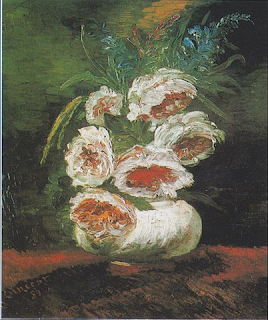When I first came to live in Palo Alto I noticed a white Peony tree in a tiny neglected garden across from Jordan Middle School, where North California street meets Middlefield Road. It was spring and the small tree was covered with enormous white flowers.
It suddenly occurred to me that I, too, can grow Peonies in my garden.
We just moved in. We designed our garden by ourselves and every weekend we created our garden. We made two small triangular beds on both sides of the short trail to our home. One bed lay at the beginning of the trail, on its left side, when you face the house, and the other at the end of the trail on the right side. We surrounded the beds with English boxwood under the impression of Kew gardens in England. In the front bed we planted three Peony bushes, in the bed close to the house we planted Peony tree.
Few years passed. The bushes disappeared during the summer. The tree was covered with healthy green leaves. We waited for the flowers.
Then one spring we opened the door and the two beds turned into a huge crown of huge, pink flowers, filling the air around with light, pleasant fragrance.
But the weather…
The sky turned grey, the wind blew.
Pouring rain hit the silk petals,
Destroying the magnificent view
The weather gave us only one day to enjoy the bouquet.
Twenty years passed since I planted the Peonies.
Every year, a wet or dry year, when the Peonies open
I know “Rain is in the horizon.”
Peonies are subject of many books, websites and art.
I will not reiterate what was already said in books and websites, but since I love legends and I love art I will repeat few famous legends and I will make a minimal Peony art exhibition. Maybe in the future I will add more legends.
One day when I retire I will devote more time to grow more Peonies and to understand their history and secrets.
A CHINES LEGEND
The legend is about a young scholar and his flowers' garden.
One day a young maiden visited the garden and admired it. The young scholar hired her as a servant, but soon she became his companion and they fell in love with one another.
One day they expected a visit by a moralist. The girl disappeared. The young scholar searched and searched for her and finally he found her in a gallery in his home. She appeared to him as a shadow fading into the wall.
"I was the soul of a peony" she told him "I had been warmed into human by your friendship and love. The moralist will not approve our love. I must return to the world of the flowers."
Then she disappeared.
The scholar went into deep mourning, continue to tend to his garden and search for her return.
He never saw her again.
(The legend appears in "The contemplation Upon Flowers by Bobby J. Ward)
PLUTO, PAEON, and AESCUAPIUS
The watchdog of Hades wounded Pluto, the ruler of the underworld.
Pluto called Paeon, the young physicians under Aesculapius, the most famous god who had the power of healing. Paeon consulted Apolo’s mother and with her help he cured Pluto
quickly with a special herb.
Aesculapius was jealous.
The fire of his jealousy flared up and he brought death upon Paeon.
Pluto was furious. He could not bring
Paeon back to life, but he turned him into a magic plant, the peony.
(The legend is one of many versions that appear in the Greek Mythology)
(The legend is one of many versions that appear in the Greek Mythology)
The myth surrounding the tale says:
“Peony is the first herb ever in
Medicine.
It can force out a devil from the
innocent.
It can eliminate a powerful
enchantment.
It can drive away a witch and
It can
scurry a ghost to its grave.”
Mischievous nymphs were said to hide in the petals of the Peony thus
causing this magnificent flower to be given the meaning of Shame or Bashfulness
in the Language of Flowers. Once planted the Peony likes to be left alone and
punishes those who try to move it by not flowering again for several years.
Once established, however, it produces splendid blooms each year for decades
(Taken from The Language of Flowers, edited by Sheila Pickles, 1990).
Diana Wells in her book “100 Flowers” tells us that Peonies can live for
hundred years or more if undisturbed.”
Peony is known as "flower of riches and honor"
and is used symbolically in Chinese art.
Peony is the state flower of Indiana since 1957.
Peony flower is the traditional floral symbol of China and
Mongolia.
Peonies, the most beautiful flowers on earth, their color,
delicate petals and light scent graced many paintings:
Pierre-August Renoir, 1880, - Peonies
Vincent Van Gogh – Vase with
Poppies, Daisies,
Cornflower and
Peonies.
Henri Fantin-Latour –
Vase of Peonies,
White Peonies and Roses Narcissu
William Merrit Chase, 1903 – Peonies
Edouard Manet, 1882 – Bouquet of Peonies
Yan Shouping – 1633 –
1690
major artist of the early Chinese Qing dynasty
Peonies in Chinese Stamps
(All the painting are
from wikipedia.org)
Our Peonies













